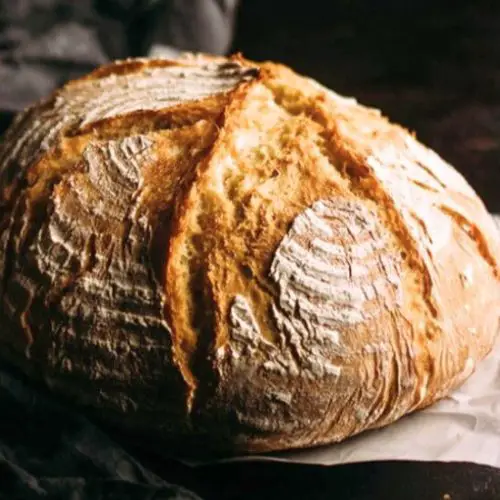
Quick Plant-Based Crusty French Bread
This Easy Crusty French Bread yields a rustic, golden loaf with a crisp crust and soft, airy interior. Quick to prepare, it’s perfect for home bakers seeking fresh, plant-based bread with minimal fuss.
Equipment
- 1 Large Mixing Bowl or Stand Mixer with Dough Hook
- 1 Dutch Oven (4–6 quarts)
- 1 Proofing Basket or Medium Mixing Bowl
- 1 Spatula
- Parchment Paper (optional but recommended)
Ingredients
- 2 ¼ tsp active dry yeast 9 g
- 1 tsp sugar 4 g (or honey as substitute)
- 1 ¼ cups warm water 300 g
- 1 ¼ tsp kosher salt 8 g
- 2 ½ –3 ½ cups all-purpose flour 400 g, plus extra for dusting
Instructions
- Activate the Yeast: Begin by combining the active dry yeast, sugar, and warm water in a large mixing bowl. The water should feel comfortably warm to the touch—around 105–110°F—to encourage yeast activity without killing it.Stir gently, then let the mixture sit undisturbed for about 5 minutes. During this time, the yeast will begin to bubble and foam, signaling that it’s active and ready to work its magic in your bread.
- Incorporate the Flour: Once the yeast is bubbly, start adding 2 ½ cups of all-purpose flour to the bowl. Use a sturdy spatula to mix the flour with the yeast mixture, stirring until a sticky, shaggy dough begins to form. Don’t worry if it looks a little uneven at this stage—the goal is just to combine the ingredients so they start to bind.
- Add Salt and Fully Combine: Sprinkle in the kosher salt over the dough. Continue mixing until the salt is evenly distributed and all traces of dry flour disappear. The dough will still feel slightly wet and sticky—that’s normal for a slack dough and is actually essential for achieving a light, airy crumb in your finished bread.
- First Rise (Bulk Fermentation): Cover your mixing bowl with a clean tea towel or plastic wrap and leave it on the counter to rise for approximately 1 hour.During this time, the dough should roughly double in size.This resting period allows the yeast to ferment and create air bubbles that will give the bread its characteristic light texture. Avoid disturbing the dough while it rises to preserve the air pockets forming inside.
- Prepare Surface for Shaping: Lightly flour a clean surface such as a large cutting board or countertop.This will prevent the dough from sticking when you transfer it. Have your hands ready, and optionally, wet them lightly with cold water to help handle the dough without it adhering to your skin.
- Shape the Dough into a Loaf: Carefully tip the risen dough onto the floured surface.Without punching it down (to preserve the delicate air bubbles), gently fold the edges toward the center like folding an envelope. Repeat a few times until the dough forms a cohesive, slightly tight round. Flip it over so the seam is facing down, then gently pull the sides to round out the loaf.Place it seam-side down into a floured proofing basket or medium bowl, lined with a clean linen napkin if desired.
- Final Rise (Proofing): Cover the shaped dough with a tea towel and allow it to rise for another 30 minutes while you preheat your oven. This final rise will give the dough extra height and enhance the open crumb structure of the bread. At this stage, the dough should look slightly puffed and springy to the touch.
- Preheat the Oven and Dutch Oven: Place your Dutch oven with its lid on into the oven and preheat to 460°F (238°C). Preheating the pot ensures it’s extremely hot, which is key for forming a crisp, golden crust. This step may take about 30 minutes, so timing the proofing with preheating helps streamline the process.
- Transfer Dough to Dutch Oven: Once preheated, carefully remove the Dutch oven from the oven using oven mitts. Optionally, lay a piece of parchment paper on your counter and gently tip the proofed dough onto it, seam-side up. Using the parchment makes transferring easier and safer. Lift the dough carefully and place it into the hot Dutch oven. Immediately cover with the lid.
- Bake with Lid On: Return the Dutch oven to the oven and bake the bread covered for 30 minutes. The lid traps steam, which helps develop a crunchy crust while keeping the interior soft and airy. Avoid opening the lid during this period to maintain consistent heat and moisture.
- Bake Uncovered for Color: After the initial 30 minutes, remove the lid. The loaf should have started forming a beautiful, light golden crust. Continue baking uncovered for an additional 10–15 minutes or until the bread reaches a deep, rich brown color and sounds hollow when tapped on the bottom. This final stage ensures a crisp exterior without drying out the interior.
- Cool and Serve: Use oven mitts and a spatula (or the edges of the parchment paper) to carefully lift the loaf from the Dutch oven onto a cooling rack. Allow it to cool for at least 30 minutes before slicing. Cooling prevents the bread from becoming gummy inside and helps set the structure. Once cooled, slice and enjoy with butter, jam, or as a base for sandwiches.
Notes
- Always proof your yeast in warm water; too hot will kill it, too cold will slow activation.
- Use a kitchen scale for precise flour measurements—this improves consistency and bread texture.
- The dough is intentionally sticky; resist the urge to over-flour, as this keeps the crumb airy.
- Avoid punching down the dough—preserving air bubbles ensures a soft, open interior.
- A Dutch oven with a tight-fitting lid creates a crisp, golden crust that mimics bakery-style bread.
- Let the bread cool completely before slicing to avoid a gummy interior.
- Optional: sprinkle flour or cornmeal on the proofing surface for added texture and easy release.